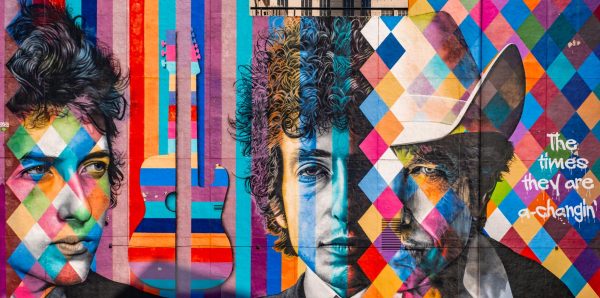Shivering, shoulders hunched in a jacket made for far warmer temperatures, TikTok discovered the allure of Bob Dylan Core in 2023, mimicking the cover of Dylan’s 1963 album, The Freewheelin’ Bob Dylan. The trend contributed to revitalizing attention to the folk singer-songwriter, often hailed as one of the greatest voices of the century. Dylan’s relevance doesn’t end on social media; his legacy has reached stages and soon the big screen. This year, a Dylan biopic starring Timothee Chalamet is slated to hit theaters, and a musical titled “Girl From the North Country” tours across the country, repurposing Dylan’s tracks in a tale about Duluth, Minnesota. While this year marks an uptick in Dylan-related media, his relevance has persisted since the height of his career in the 1960s and 70s. He even won a Nobel Prize for literature in 2016. Dylan, an artist often dubbed Americana, serves as a national emblem beyond his sound. So, how has a man from Hibbing, Minnesota—whose career has spanned over half a century—remained deeply relevant without really trying?
For the most part, the American public remembers Dylan as a positive emblem of the 60s, representing freedom-seeking cultural sentiments without veering into the fray of true radicalism. Remembering Dylan allows listeners and fans to connect with a decade of social change and resistance from a fairly mainstream perspective. Celebrating Bob Dylan seems to be America’s way of finding a legacy of the 60s and a touchstone for what America means. Dylan is countercultural, not radical, romantic without pining, and a boy from humble beginnings in Minnesota’s Northwoods who found his way to dazzling fame in New York City. His career brought him from the rural Minnesota mining class to worldwide notoriety, but much of his appeal emerges from the former.
Dylan’s songs ring with authenticity while being widely relatable. He does not easily fall into one American caricature, which is perhaps why such a wide swath of Americans love him.
However, this does not mean everyone remembers and listens to Dylan fondly. Some find that his voice resembles that of a drowning cat or that his lyrics leave something to be desired.
Although he dubbed himself “apolitical” midway through his career, some of his most popular songs are in fact political, responding to the Vietnam War and social change. Dylan adopted a left-lite audience through his music, warmly antiwar and poetically critical. Songs like “The Times They Are A-Changin” and “Blowing In the Wind” promote peace and understanding, yet Dylan himself firmly rejected anything that “took sides.” He denounced the two parties and referred to politics as “trivial” while performing at the March on Washington. He leaves the charged meanings of his songs up for interpretation—or not. It is due to this one-size-fits-all progressivism that Dylan’s legacy has remained so intact and his music always timely; people like what he has to say because it can be so broad. His antiwar songs have been used to call for the end of Israel’s attack on Gaza, and others referred to as “Zionist anthems.”
Connection to Dylan is especially strong in the Twin Cities, where the artist spent his early career years performing in Dinkytown. He moved from Hibbing to the Cities to study at the University of Minnesota, even pledging to the fraternity Sigma Alpha Mu, before failing out of school and pursuing music full-time. In a rare interview in 2017, he referred to Minneapolis and St. Paul as underground “rock and roll towns” in the 60s. However, Dylan didn’t stick around.
“Heading out for the East Coast, Lord knows I’ve paid some dues getting through,” Dylan sings in “Tangled Up In Blue.” Head-for-the-East-Coast he did; Dylan moved to New York at 19 and quickly became a part of their local folk scene.
Although Dylan skipped town pretty early in his career, he never fully forgot about Minnesota in his music. Songs such as “A Girl From The North Country” and “North Country Blues” refer to his land-of-sky-blue-waters. Minnesota never forgot him either. The state clings to its homegrown boy through murals and festivals, despite his quick getaway.

Source: Sharon Mollerus on Flickr Creative Commons.
Unlike Prince, another notable Minnesotan artist, Dylan never came back or clung to his identity as a Minnesotan. Like the rest of his public views, his attitude towards his roots is relatively apathetic. That is the allure of Dylan. Despite being a part of the American musical lexicon, he doesn’t feel the need to carve out his legacy for himself, and in turn, others seem to be doing the work for him. Dylan’s listening numbers remain high and new versions of old albums and performances continuously update his discography. The Dylan TikTok trend will fade if it hasn’t already, but the Nobel-winning singer and poet will remain loved by many Americans due to his folksy sound and small-town roots.